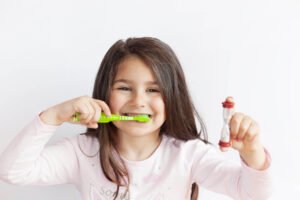At Little Smiles of Beverly Hills, led by Dr. Sepehr Nassiripour, we understand that your child’s oral health is deeply connected to their overall well-being. Our practice, nestled in Beverly Hills, embraces a comprehensive, whole-child approach to dental care. We champion prevention, education, and creating a warm, comfortable environment that makes every child feel at ease. Therefore, when it comes to laying the groundwork for a lifetime of healthy teeth, mastering the use of fluoride & baby toothbrushes is absolutely vital.
Understanding Fluoride: A Partner for Baby Toothbrushes
Fluoride is a naturally occurring mineral that acts like a superhero for your child’s developing teeth, providing robust protection against decay. Indeed, when combined with the right baby toothbrushes, fluoride effectively strengthens enamel and promotes repair. But how does this powerful mineral work its magic?
- Strengthening Enamel: First, fluoride actively helps to replenish lost minerals in tooth enamel, making it significantly more resilient to the acid attacks caused by oral bacteria.
- Promoting Repair: Furthermore, it kickstarts the remineralization process, which can even repair early damage to the enamel before it turns into a full-blown cavity.
This protective action is incredibly important, especially for primary (baby) teeth, which are more vulnerable to decay. Consequently, when seamlessly combined with diligent home care—like limiting sugary treats, regular brushing and flossing, and consistent visits to your pediatric dentist—fluoride genuinely paves the way for a lifetime of radiant smiles for every child. Proactive fluoride application is undeniably a cornerstone of modern preventive dentistry.
Understanding Fluoride Safety and Application
While incredibly beneficial, using fluoride safely and in the correct amounts is key to avoid fluorosis, a cosmetic condition that can cause faint white specks on permanent teeth. Rest assured, our pediatric dentists at Little Smiles of Beverly Hills meticulously monitor fluoride levels to ensure your children receive precisely the optimal amount they need. It’s a vital tool in modern dentistry.
Here’s a simple guide for fluoride toothpaste use:
- Children under two: Stick to non-fluoridated toothpaste.
- Children aged two to five: Use just a pea-sized dab of ADA-approved fluoridated toothpaste twice daily, gently encouraging them to spit out any excess.
- Children over eight: Generally, these children are no longer considered at risk for fluorosis, but they should continue to use ADA-approved fluoridated toothpaste.
Fluoride can be delivered in various beneficial ways:
- Topical Fluoride: For instance, it’s a key ingredient in many toothpastes, oral gels, and mouthwashes.
- Community Water Fluoridation: Additionally, most community water supplies are fluoridated, providing a consistent, low-dose exposure.
- Supplements: For children at high risk for tooth decay, a pediatric dentist might recommend at-home fluoride supplements.
- Professional Applications: Moreover, during office visits, your dentist can apply topical fluoride in forms like foams, liquids, gels, or a quick-setting fluoride varnish. Fluoride varnish is a wonderfully convenient and effective method for fortifying each tiny tooth.
Fluoride Recommendations at a Glance
| Age Group | Toothpaste Type | Amount of Toothpaste | Key Considerations |
| Under 2 | Non-fluoridated | None (or water only) | Focus on cleaning gums and first teeth; no swallowing of toothpaste. |
| 2-5 years | ADA-approved fluoridated | Pea-sized | Encourage spitting out excess; supervision for the child is crucial. |
| 6-8 years | ADA-approved fluoridated | Pea-sized | Continue supervision to ensure proper brushing and spitting. |
| Over 8 | ADA-approved fluoridated | Pea-sized (or more) | Generally not at risk for fluorosis; embrace excellent oral hygiene. |
Choosing Baby Toothbrushes: A Guide to Optimal Oral Care
Choosing the right toothbrush is more than just a purchase; it’s a pivotal step in fostering excellent brushing habits from a very young age. The secret, therefore, lies in selecting a baby toothbrush that’s safe, comfortable, and perfectly sized for your child’s unique age and developmental stage. This section details essential features for effective baby toothbrushes.
Essential Baby Toothbrush Features to Look For:
- Bristle Softness: Always, always choose extra-soft or soft bristles. A baby’s delicate gums and newly erupted teeth need the gentlest touch to prevent any irritation or potential damage to the enamel.
- Brush Head Size: The toothbrush head should be small and compact enough to fit comfortably inside your child’s mouth, allowing it to reach all tooth surfaces, even those tricky back molars. Steer clear of oversized or bulky heads.
- Handle Design: Opt for a handle that’s easy for parents to grip during assisted brushing. As your little one grows, look for designs that small hands can easily grasp independently, often featuring chubby, non-slip grips.
- Material Safety: Finally, verify that the toothbrush is explicitly labeled BPA-free and crafted from non-toxic materials. Ensure there are no small, detachable parts that could pose a choking hazard.
Age-Specific Baby Toothbrush Recommendations:
| Age Group | Recommended Toothbrush Type | Key Features |
| Infancy | Soft cloth, dental sponge, silicone finger brush | Exceptionally gentle on gums, helps babies become accustomed to oral care. |
| First Tooth | Baby toothbrush (very small head, ultra-soft silicone bristles), finger toothbrush | Specifically designed for the first emerging tooth, offering parental control and gentle cleaning. |
| Toddlerhood | Toddler toothbrush (small head, extra-soft/soft bristles) | Features an easy-grip handle for parent and child, promotes participation. |
| Preschool & Early Childhood | Kids’ manual toothbrush (soft bristles), electric toothbrush (optional) | Age-appropriate size, fun designs. Electric options may include timers or apps; continued parental supervision is vital. |
Cultivating Joyful Brushing Habits
Beyond just picking the right toothbrush, making brushing a positive and engaging experience is paramount. Dr. Nassiripour and the dedicated team at Little Smiles of Beverly Hills emphasize transforming brushing from a daily chore into a cherished family ritual. This can involve using songs, stories, or making it a playful adventure. Supervise your child’s brushing until they are at least 7 or 8 years old to ensure they’re using the correct technique and consistently spitting out the toothpaste. Indeed, every healthy tooth is a victory toward overall well-being.
By understanding the benefits of fluoride and choosing the right tools, you’re setting your child up for a lifetime of healthy, happy smiles. Little Smiles of Beverly Hills is committed to your family’s oral health journey.
Your Questions Answered: Fluoride & Baby Toothbrushes
Here are some common questions parents often ask us about fluoride & baby toothbrushes:
Getting Started with Fluoride and Baby Toothbrushes
You should begin cleaning your baby’s gums even before their teeth make an appearance, using a soft, damp cloth or a silicone finger brush. Once that first tooth erupts (typically around 6 months), it’s time to introduce a baby toothbrush with a tiny smear of non-fluoridated toothpaste (or just water).
Yes, fluoride is safe and highly effective when used in appropriate amounts. Pediatric dentists carefully monitor fluoride levels to ensure your child receives the exact right amount for their age to prevent both cavities and fluorosis.
For children under two, use non-fluoridated toothpaste or simply water. For those aged two to five, a pea-sized amount of ADA-approved fluoridated toothpaste is sufficient. Children over five can use a pea-sized amount or slightly more, always based on their dentist’s recommendation.
Addressing Common Concerns and Choices
Fluorosis is a cosmetic condition that can appear as faint white specks or streaks on tooth enamel if a child consumes too much fluoride while their permanent teeth are still developing. To prevent it, ensure your child uses the correct amount of toothpaste for their age and consistently spits out any excess.
Both manual and electric toothbrushes can be highly effective. For very young children, a manual toothbrush often provides parents with better control. As children grow, an electric toothbrush can be a fun and motivating tool, frequently offering features like built-in timers to ensure adequate brushing time. The best choice often depends on your child’s preference and your pediatric dentist’s advice.
You should replace your child’s toothbrush every three to four months, or sooner if you notice the bristles becoming frayed or worn. It’s also a good practice to swap it out after your child has been sick.
While swallowing a very small amount of fluoride toothpaste occasionally isn’t typically harmful, consistent swallowing can lead to fluorosis. Encourage your child to spit out the toothpaste after brushing. Parental supervision is key until they can reliably spit.
Optimizing Oral Hygiene for Your Child
Always choose toothbrushes with extra-soft or soft bristles, regardless of whether they are made of silicone or nylon. These are designed to be supremely gentle on delicate gums and newly emerging teeth, preventing irritation and potential damage to each precious tooth.
You should introduce flossing to your child’s routine as soon as any two teeth touch each other. Your pediatric dentist can provide a demonstration of the proper flossing technique tailored for children.
At Little Smiles of Beverly Hills, we provide comprehensive pediatric dental services, ranging from preventative care and essential education to minimally invasive treatments. We focus on creating a positive dental experience for your child, fostering healthy habits that last a lifetime, and addressing their unique needs to ensure truly radiant smiles.
Your Partner in Nurturing a Lifetime of Healthy Smiles
Ensuring your child has a healthy smile from the very beginning is truly one of the most precious gifts you can bestow upon them. By understanding the protective prowess of fluoride and thoughtfully choosing the ideal baby toothbrush for each exciting developmental stage, you are actively laying a robust foundation for lifelong oral health. This comprehensive guide to fluoride & baby toothbrushes aims to empower you with the knowledge needed for your child’s best dental start. Remember, consistent home care, seamlessly combined with regular professional dental visits, forms the ultimate shield against cavities and other concerns.
At Little Smiles of Beverly Hills, we are passionately committed to transforming dentistry into a delightful adventure for every child who walks through our doors. Our dedicated team is here to support you with expert advice and the most gentle care, from the joyful eruption of the very first tooth through to their adolescent years. We invite you to explore our comprehensive services, learn more about us and our philosophy, and feel free to contact us to schedule an appointment. Let’s work together to nurture those beautiful little smiles in Beverly Hills!
References & Resources (Outbound Links):
- Fluoride Information from BH-LAX Smiles: https://www.bh-laxsmiles.com/procedures/pediatric-dentistry/fluoride/
- Little Smiles of Beverly Hills Official Website: https://littlesmilesofbeverlyhills.com/
- Choosing the Best Toothbrush for Toddlers: https://littlesmilesofbeverlyhills.com/choosing-the-best-toothbrush-for-toddlers/
- Best Training Toothbrush for Babies: https://littlesmilesofbeverlyhills.com/the-best-training-toothbrush-for-babies/
- Making Teeth Brushing Fun: https://littlesmilesofbeverlyhills.com/making-teeth-brushing-fun-for-children/
- General Information on Baby Toothbrushes: https://childrensdentalhealth.com/toothbrushes-and-toothpaste-timeline-for-children/
Internal Links to Little Smiles of Beverly Hills:
- Explore Our Services: https://littlesmilesofbeverlyhills.com/services/
- Learn More About Us: https://littlesmilesofbeverlyhills.com/about-us/
- Contact Little Smiles of Beverly Hills: https://littlesmilesofbeverlyhills.com/contact-us/



